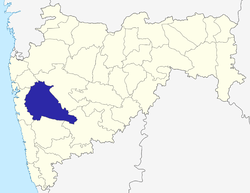Junnar
| Junnar | |
|---|---|
| city | |
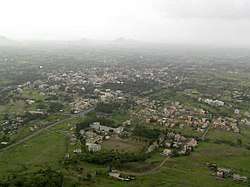 Junnar city | |
 Junnar Location in Maharashtra, India  Junnar Junnar (Maharashtra) | |
| Coordinates: 19°12′N 73°53′E / 19.2°N 73.88°ECoordinates: 19°12′N 73°53′E / 19.2°N 73.88°E | |
| Country |
|
| State | Maharashtra |
| District | Pune |
| Elevation | 689 m (2,260 ft) |
| Population (2011) | |
| • Total | 36,567 |
| Languages | |
| • Official | Marathi |
| Time zone | UTC+5:30 (IST) |
| Website | Junnar Tourism Website |
Junnar is a city with thousands of years of history in the Pune district of the Indian state of Maharashtra.[1] The nearby fort of Shivneri is the birthplace of Shivaji, the founder of the Maratha Empire.
History
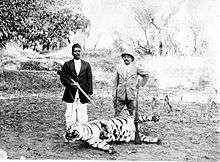
Junnar has been an important trading and political center for the last two millennia. The town is on the trade route that links the ports of western India or more specifically of Konkan with Deccan interiors. The first mention of Junnar comes the Greco -Roman travellers from the first millennium,[2][3][4] The Indo-Scythian Western Satraps ruled at Junnar during the 2nd century CE as shown by their cave inscriptions in the area of Junnar, at Manmodi caves.[5] "Yavana" Greeks also left donative inscriptions in the 2nd century CE at Lenyadri and Manmodi caves.[6]
In the 1400s, the Russian traveler, Afanasy Nikitin spent many months in Junnar during the monsoon season. He describes vividly the life of the Bahamani governor ruling area around Junnar.[7] The Nizam Shahi had Junnar as their first capital.[8] Later in early 1600s, Malik Ambar the Nizam Shahi general moved his capital there.[9] The father of Shivaji, Shahaji Raje worked for Malik Ambar early in his career. Shivaji was born at the nearby Shivneri fort.
Geography
Junnar has an average elevation of 689 metres (2260 feet).[10] State Transport buses run between Pune and Junnar from Shivajinagar ST stand. The Kukadi River flows to the north.
Teak Forest
The Junnar area has been historically famed for its teak forest. The Shaniwar Wada, the de facto seat of government of the Maratha Empire in Pune was completed in 1732 by Peshwa Bajirao I.Teak from Junnar was used extensively in its construction..
Demographics
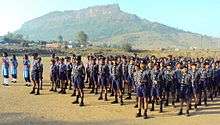
As of 2001 India census,[11] Junnar had a population of 24,740. Males constitute 52% of the population and females 48%. Junnar has an average literacy rate of 77%, higher than the national average of 59.5%: male literacy is 81%, and female literacy is 72%. In Junnar, 12% of the population is under 6 years of age.
Transport
State Transport buses run between Pune and Junnar from Shivajinagar ST stand from 0630 every hour. Also bus facility available from Mumbai (kalyan) for every 10–30 minutes from 05:20 AM till 12:30 AM. Same is the case from Ahamadnagar and Nashik. Transportation from Ahamadnagar and Mumbai takes a route of NH 222 while from Pune and Nashik will take a route of NH 50.
Junnar Tourism
Junnar area is dotted with historic places including Shivneri, the birthplace of Shivaji maharaj (1630), the cave temple of Lenyadri; One of the famous temple of Lord Ganesha Ozar and the walled town of Junnar itself. And Junnar has historical under ground water chain built by Shia Muslim intellectual Malik Ambar which it exists at Sayyed Wada (hauz) Junnar and Pirzade Wada. Both water reservoirs exist today
Shivneri Fort
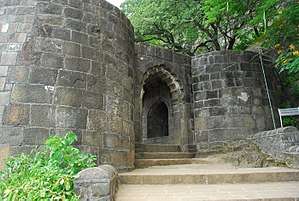
Jivdhan Fort
Jivdhan, Jivdhan (or Jeevdhan) is a hill fortress situated 1 km near the modern day town of Ghatghar in Junnar Taluka of Pune district in Maharashtra, India.
Hadsar Fort
Hadsar, fort is among the many forts in Junnar region of Pune district which were meant for protection of the ancient commercial trade route from Mawal region to Kalyan via Naneghat. There is a marvelous sculpture design of the bastion and the fort entrance, which is not seen elsewhere. They are all carved from a single rock.
Cave temples
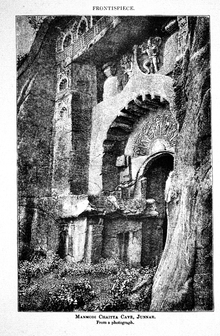
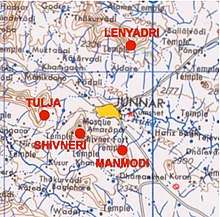
Surroundings of Junnar are very rich with ancient cave temples. In total there are more than 220 individual rock-cut caves located in four hills around Junnar.[12] Junnar has the largest and longest cave excavations in India.[13] The most famous among the caves is the Lenyadri complex. It represents a series of about 30 rock-cut mostly Buddhist caves. Cave 7 is a famous Hindu temple dedicated to the god Ganesha. It is one of the Ashtavinayak shrines, a set of the eight prominent Ganesha shrines in Maharashtra. Twenty-six of the caves are individually numbered. The caves face to the south and are numbered serially from east to west.[14][15][16] Caves 6 and 14 are chaitya-grihas (chapels), while the rest are viharas (dwellings for monks). The latter are in the form of dwellings and cells. There are also several rock-cut water cisterns; two of them have inscriptions. The layout of the caves, in general, are similar in pattern and shape. They generally have one or two sides with two long benches for occupants' use.[14][15][16] The caves date from between the 1st and 3rd century AD; the Ganesha shrine situated in Cave 7 is dated to the 1st century AD,[14][17] though the date of conversion to a Hindu shrine is unknown. All of the caves arise from Hinayana Buddhism.[14]

The caves of Junnar are grouped according to the following classification:[18]
- Tulja Leni or Tuljalena, on the Tuljabai hill, 4 km west of Junnar.
- Shivneri group or Sivaneri group, 3km southwest of Junnar.
- East facing group (1, 2, and 3)
- West facing group
- South facing group
- Manmodi group, on Manmodi hill, 3km south of Junnar.
- Bhimasankar group
- Amba-Ambika group
- Bhutalinga group
- Lenyadri or Ganesh lena group, 5km north of Junnar.
About 20km to the northwest of Junnar, the Naneghat caves can also be seen.
Yavana donations
Several inscriptions related to donations by Yavanas (Indo-Greeks) have been found at the Junnar caves.[19] These inscriptions are located in the Shivneri caves:[20]
- One inscription mentions the gift of two cisterns to the monks by a Yavana donor named Irila.[19][21]
- Another inscription mentions the gift of a dining hall to the samgha by a Yavana donor named Chita.[19][21]
At Manmodi caves, another Yavana donor named Chanda dedicated a hall front to the Samgha.[19][21]
Similar donations by Yavanas can be found at the Nasik caves and the Great Chaitya of the Karla caves.[19][21]
Agritourism
Agritourism or agrotourism, as it is defined most broadly, involves any agriculturally based operation or activity that brings visitors to a farm or ranch. Few popular such venture, "Parashar Agri & Village Tourism centre", is situated in village Rajuri of Junnar Taluka, and other Rashmigreenland Agri Tourism Center, located at foot hills of Leynadri temple, Golegaon, Junnar
An emerging group of youth from junnar are trying new trends into business of agrotourism. Arranging Treks, tours, leaving in countryside, tents under the sky are features you can tried out here with them. Easy accessible from Pune, Mumbai and Nashik
Leopard
Many times leopards attack people and animals in Junnar. According to field studies carried out in Junnar, the man-leopard crisis has been wrought about not only by development but by the recent translocations of the leopards that has disrupted the formerly harmonious man-beast coexistence. Very often leopards have attacked villagers in Junnar. There is a leopard rescue centre located at Manikdoh for this cause
References
| Wikimedia Commons has media related to Junnar. |
- ↑ "Forest law trampled in Junnar, Abhi-Ash's Ravan in trouble". Retrieved 22 August 2009.
- ↑ Margabandhu, C. "Trade Contacts between Western India and the Graeco-Roman World in the early centuries of the Christian era." Journal of the Economic and Social History of the Orient/Journal de l'histoire economique et sociale de l'Orient (1965): 316-322.
- ↑ Rath, Jayanti. "QUEENS AND COINS OF INDIA."
- ↑ Deo, S. B. "The Genesis of Maharashtra History and Culture." Bulletin of the Deccan College Research Institute 43 (1984): 17-36.
- ↑ Journal of the Asiatic Society of Bombay. Asiatic Society of Bombay. 1986. p. 219.
If Konow is right, then the length of time for Ksatrapa rule in the Nasik-Karla-Junnar region would be at least thirty-fire years.
- ↑ Religions and Trade: Religious Formation, Transformation and Cross-Cultural Exchange between East and West. BRILL. 2013. p. 97. ISBN 9789004255302.
- ↑ Fisher, edited by Michael H. (2007). Visions of Mughal India : an anthology of European travel writing. London: I. B. Tauris. pp. 15–18. ISBN 978-1-84511-354-4. Retrieved 6 July 2016.
- ↑ "Poona District Nizam Shahis, 1490-1636". Maharashtra. Government of Maharashtra. Retrieved 12 July 2016.
- ↑ Eaton, Richard M. (2005). The new Cambridge history of India (1. publ. ed.). Cambridge: Cambridge University Press. p. 118. ISBN 0-521-25484-1. Retrieved 6 July 2016.
- ↑ Falling Rain Genomics, Inc - Junnar
- ↑ "Census of India 2001: Data from the 2001 Census, including cities, villages and towns (Provisional)". Census Commission of India. Archived from the original on 2004-06-16. Retrieved 2008-11-01.
- ↑ "Lenyadri Group of Caves, Junnar". Archaeological Survey of India. Retrieved 30 May 2010.
- ↑ http://www.ncert.nic.in/NCERTS/textbook/textbook.htm?kefa1=0-8
- 1 2 3 4 "Lenyadri Group of Caves, Junnar". Archaeological Survey of India official site. Archaeological Survey of India, Government of India. 2009. Retrieved 4 February 2010.
- 1 2 "Junnar". Gazetteer of the Bombay Presidency. 18. Govt. Central Press. 2006 [1885]. Archived from the original on October 16, 2009. Retrieved 2010-02-02.
- 1 2 Edwardes, S. M. (2009). By-Ways of Bombay. The Ganesh Caves. Echo Library. pp. 34–36. ISBN 1-4068-5154-X. Retrieved 2010-02-26.
- ↑ Feldhaus p. 143
- ↑ "Lenyadri Group of Caves, Junnar - Ticketed Monument - ArchaeologicalSurvey of India". asi.nic.in. Archaeological Survey of India.
- 1 2 3 4 5 Religions and Trade: Religious Formation, Transformation and Cross-Cultural Exchange between East and West, BRILL, 2013 p.97 Note 97
- ↑ "The Junnar Cave 18 speaks of three Yavanas...." in Some Aspects of Ancient Indian Culture - D. R. Bhandarkar - 1989, p.60
- 1 2 3 4 Yavana (Ionian) donors of the Buddhist cave architecture in Western India (AD 100- AD 250), Anuradha K. Ranade pp 829-831
